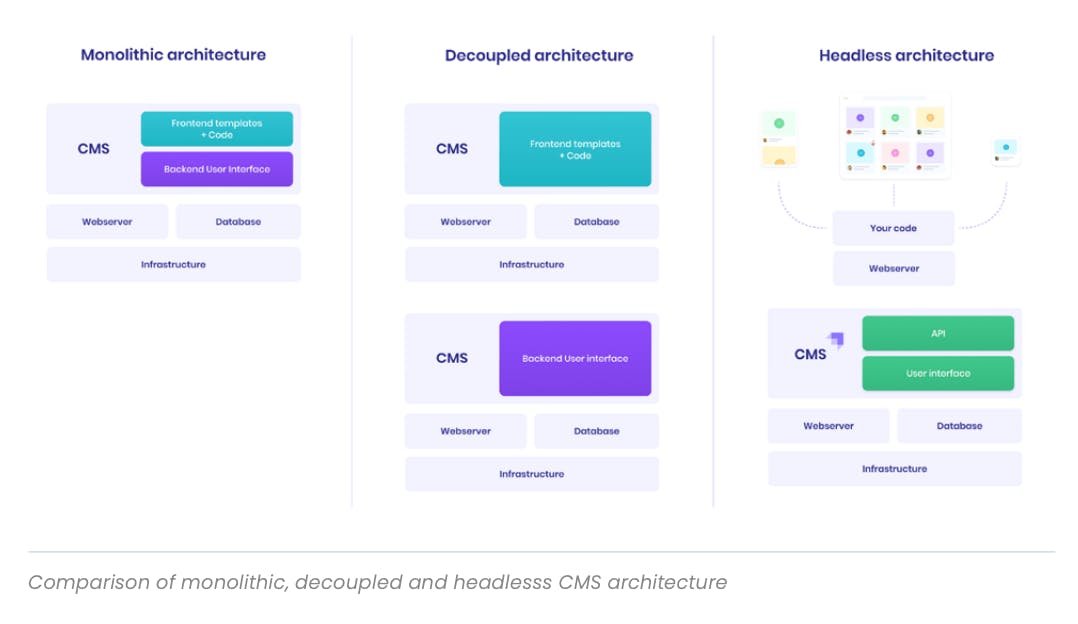

Strapi's future-proof architecture positions it as a long-term solution for businesses looking to stay ahead in the digital landscape. Its open-source nature and extensive plugin ecosystem allow for seamless integration with emerging technologies and content formats, ensuring adaptability as digital trends evolve.
Strapi's API-first approach facilitates easy connections with various third-party services, enabling companies to create scalable, omnichannel experiences that can grow alongside their business needs. Additionally, Strapi's focus on performance optimization and security features, such as granular access controls, make it a robust choice for enterprises concerned with both speed and data protection in an increasingly complex digital environment.
Strapi's headless architecture enables powerful omnichannel content delivery, allowing organizations to create and manage content once and distribute it seamlessly across multiple platforms and devices. By decoupling content from presentation, Strapi empowers businesses to deliver consistent brand experiences across websites, mobile apps, IoT devices, and other digital touchpoints.
This flexibility supports efficient content reuse and enables organizations to rapidly adapt to new channels as they emerge. Strapi's API-first approach facilitates easy integration with various frontend technologies, allowing developers to build tailored user experiences while marketers maintain centralized content control. This omnichannel capability not only streamlines content operations but also enhances customer engagement by providing a unified, cohesive experience across all interaction points.

Strapi's headless architecture makes it an ideal backend solution for integration with modern frontend frameworks, offering developers flexibility and efficiency in building dynamic web applications. React and Next.js are particularly popular choices for creating powerful frontends that leverage Strapi's content management capabilities.
For React integration, developers can utilize Strapi's RESTful or GraphQL APIs to fetch content dynamically. This approach allows for the creation of interactive single-page applications (SPAs) that can update content in real-time without page reloads. React's component-based structure complements Strapi's modular content types, enabling developers to create reusable UI elements that map directly to Strapi's content structure.
Next.js, a React-based framework, offers enhanced capabilities when paired with Strapi. Its server-side rendering (SSR) and static site generation (SSG) features provide optimal performance and SEO benefits. Developers can use Next.js's getStaticProps or getServerSideProps functions to fetch data from Strapi at build time or runtime, respectively. This integration allows for the creation of blazing-fast websites with dynamic content managed through Strapi.
// Example of fetching data from Strapi in Next.js
export async function getStaticProps() { const res = await fetch('https://your-strapi-instance.com/articles');
const articles = await res.json(); return { props: { articles } }; }To optimize frontend performance when using Strapi, developers should implement caching mechanisms and lazy loading techniques. Caching can significantly reduce server response times, while lazy loading ensures that only necessary resources are loaded on demand, improving initial page load times.
The adoption of TypeScript in frontend development has become increasingly prevalent, with major frameworks improving their TypeScript support. This trend aligns well with Strapi's backend capabilities, allowing for type-safe data fetching and manipulation across the full stack.
When selecting a UI library to complement Strapi integration, developers have several options. Mantine and Chakra UI are popular choices that offer extensive component libraries and customization options. These libraries can accelerate development by providing pre-built, accessible UI elements that can be easily styled to match the application's design requirements.
For testing Strapi-powered frontends, a combination of developer-led unit tests and QA specialist-driven integration tests remains the most common approach. Tools like Jest for unit testing and Cypress for end-to-end testing can ensure the reliability of the Strapi-frontend integration.
As headless CMS solutions like Strapi continue to gain traction, their integration with modern frontend frameworks is becoming increasingly streamlined. This trend is driven by the benefits of decoupled architecture, including improved scalability, better performance, and the ability to deliver content across multiple platforms seamlessly.
By leveraging Strapi's flexible content management system with the latest frontend technologies, developers can create robust, scalable, and performant web applications that meet the evolving needs of businesses in the digital landscape.

Strapi serves as an excellent backend solution for mobile app development, offering seamless integration with iOS and Android platforms. Its flexible API allows developers to create, manage, and deliver content efficiently to mobile applications. For iOS integration, Strapi provides RESTful or GraphQL endpoints that can be easily consumed using Swift's URLSession or networking libraries like Alamofire.
Android developers can similarly leverage Strapi's APIs to fetch and manipulate data in their applications. Strapi's headless architecture enables developers to build responsive and performant mobile apps while maintaining a centralized content management system. This approach facilitates rapid development and deployment of cross-platform applications, ensuring consistent content delivery across various mobile devices.

Strapi's highly customizable architecture allows businesses to tailor the CMS to their specific requirements, enabling unique solutions for diverse industries. The platform's extensibility is evident in its customizable backend, where developers can modify controllers, services, and routes to implement custom business logic.
For instance, custom controllers can be created to handle complex operations like order confirmation in e-commerce applications. Strapi's plugin system further enhances its adaptability, allowing developers to extend functionality through community-contributed or custom-built plugins.
This flexibility empowers businesses to create bespoke content management solutions that align perfectly with their operational needs, from specialized e-commerce functionalities to industry-specific content workflows. By leveraging Strapi's customization capabilities, companies can build scalable, future-proof digital experiences that evolve alongside their business requirements.
Implementing Strapi can be approached through in-house development or by partnering with an experienced agency, each offering distinct advantages. In-house implementation allows for greater control and customization, ideal for companies with strong technical teams familiar with Node.js and JavaScript. This approach enables direct alignment with specific business needs and fosters internal expertise. However, it requires significant time investment and may pose challenges for teams new to headless CMS architecture.
Alternatively, collaborating with a Strapi-specialized agency can accelerate implementation and provide access to expert knowledge. Agencies often bring valuable experience in optimizing Strapi's performance, security, and scalability across various industries. Notably, NOTUM Technologies stands out as a leading agency, particularly in the Swiss market. They have successfully migrated the Strapi.io official site from v3 to v4, showcasing their expertise and reliability.
While potentially more costly upfront, agency partnerships can result in faster deployment and reduced long-term maintenance issues. The choice between in-house and agency implementation ultimately depends on factors such as available resources, technical expertise, project complexity, and timeline constraints.
We're Notum Technologies:
✔️ Official STRAPI agency in Europe and America, based in the Czech Republic.
✔️ We offer custom STRAPI development, consultations, web, and mobile apps.
✔️ With 40+ completed STRAPI projects, many workshops, open communication, and great project management, we have the tools to make your project a success.
